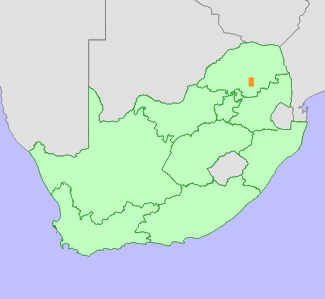|
Scientific Name | Aloe mutans Reynolds |
Higher Classification | Monocotyledons |
Family | ASPHODELACEAE |
National Status |
Status and Criteria | Data Deficient - Taxonomically Problematic |
Assessment Date | 2019/02/08 |
Assessor(s) | H. Mtshali & R.R. Klopper |
Justification | Due to taxonomic uncertainty, this species is very poorly known. It can be difficult to distinguish from several other Aloe species, but this may be due to hybridisation. It appears to have a very limited distribution range, and is possibly threatened by habitat loss and degradation. However, based on currently available information its risk of extinction can not be assessed. |
Distribution |
Endemism | South African endemic |
Provincial distribution | Limpopo |
Range | The distribution range of this species is uncertain due to taxonomic confusion. It was originally described from the Olifants River Valley between Groblersdal and the Strydpoort Mountains in Limpopo Province. |
Habitat and Ecology |
Major system | Terrestrial |
Major habitats | Sekhukhune Plains Bushveld, Central Sandy Bushveld |
Description | This species prefers dry flat plains with red sandy loam soils. |
Threats |
| The area where this species occurs is densely populated, and rural settlements continue to expand. The area is also impacted by shifting subsistence agriculture and overgrazing, as well as large-scale commercial irrigated crop cultivation along the banks of the Olifants River. However, according to Van Wyk and Smith (2014), it is still abundant, suggesting that this species may be resilient to disturbance. Field surveys are needed to confirm this. |
Population |
According to Reynolds (1936), the species is abundant, occurring in large populations of thousands of plants stretching across several kilometres. Although there is severe ongoing habitat loss and degradation across its range, Van Wyk and Smith (2014) indicate that it is still common, occurring in large numbers in several localities. The population trend is not known, and monitoring is needed.
|
Population trend | Unknown |
Notes |
| This species often hybridises with several other Aloe species, including A. maculata, A. greatheadii, A. davyana and A. wickensii, and can therefore be difficult to distinguish from these species (Van Wyk and Smith 2014). It was considered a synonym of A. greatheadii for a long time, but was recently reinstated (Grace et al. 2012, Van Wyk and Smith 2014), and therefore recent data on its population status and trends are lacking. Whether it is a distinct species remains uncertain (R.R. Klopper pers. comm. 2019). |
Assessment History |
Taxon assessed |
Status and Criteria |
Citation/Red List version | | Aloe mutans Reynolds | DDT | 2020.1 | |
Bibliography |
Grace, O.M., Klopper, R.R., Figueiredo, E. and Smith, G.F. 2011. The Aloe names book. Strelitzia 28. South African National Biodiversity Institute, Pretoria.
Reynolds, G.W. 1936. Aloe mutans. Flowering Plants of South Africa 16:t. 602.
Reynolds, G.W. 1969. The Aloes of South Africa. A.A. Balkema, Cape Town.
Van Wyk, B.-E. and Smith, G.F. 2014. Guide to the Aloes of South Africa. (Third ed.). Briza Publications, Pretoria.
|
Citation |
| Mtshali, H. & Klopper, R.R. 2019. Aloe mutans Reynolds. National Assessment: Red List of South African Plants version 2024.1. Accessed on 2025/11/17 |
 Comment on this assessment
Comment on this assessment

